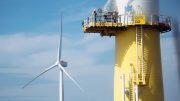Cleanup of high-radioactive nuclear heritage from the Cold War – Hazardous fuels are removed from Kola
High-radioactive uranium fuel from Soviet nuclear submarines has been stored for four decades under highly unsatisfactory conditions at Kola. Now the cleanup starts.
Tuesday marks a milestone in Russian atomic cleanup and Norwegian-Russian nuclear cooperation. Minister of Foreign Affairs, Børge Brende (H), will be present when the Italian specialty vessel Rossita leaves from the harbour at the former submarine base, which is only 50 kilometers in line from the Norwegian border.
Rossita will bring about 700 fuel rods on its first trip to Murmansk where the containers will be transferred to the railroad. The Majak end station is more than 3,000 kilometers further east. Here uranium and plutonium will be removed at a reprocessing plant.
Minister of Foreign Affairs, Børge Brende, points out that Norway has cooperated with Russia for more than 20 years to clean up nuclear waste after the Cold War and that it is important for both the population and environment throughout the Barents region.
– It has been a demanding and complicated effort to secure the spent nuclear fuel and prepare it for transport to the final storage site in the Urals. I am therefore pleased that the first load is now ready for shipment. This is one thing I’ve been following since my time as Minister for the Environment, Brende told NTB.
Largest accumulation
Unlike US nuclear submarines, the Soviet fuel did not last the lifetime of the submarine. In Andrejeva Bay, the fuel rods from the reactors were replaced. At that time, neither the storage conditions nor the ability to handle the waste had been arranged.
– Therefore, for decades, struggling with this nuclear heritage has been difficult. This is probably what makes Andrejeva Bay the worst and largest accumulation of spent nuclear fuel we know of. The conditions here are worsened, and you have to deal with this before they get even worse, says section manager Ingar Amundsen in the Norwegian Radiation Protection Agency to NTB.
The cleanup in Andrejeva has high priority in the Norwegian-Russian nuclear safety cooperation.
-This work is a Russian responsibility, but under Russian leadership has included international contributions from several countries and organizations. Norway has contributed with both funding and expertise. Atomic challenges do not know any borders, and for Norway it has been important to contribute, says the Minister of Foreign Affairs.
Temporary storage tanks
A fatal accident at the plant in 1982 led to the fact that the fuel rods for the next three years had to be moved to three concrete tanks that are not suitable for the purpose. Andrejeva bay contains a formidable 22,000 fuel rods from nuclear submarines and civilian atomic ice breakers in addition to large amounts of solid and liquid radioactive waste.
– The tanks were built to store low-radioactive waste and were supposed to be a temporary solution, but have been in use until today. Part of the fuel in mind is probably solidified and has been untouched since 1985. It can lead to unpleasant surprises. If you get fuel that is stuck, the entire fuel element can shrink and lead to a serious situation, says nuclear physicist and CEO in the environmental organization Bellona, Nils Bøhmer, to NTB.
Must be followed up
Bellona emphasizes that it is important that Norwegian authorities be present and follow up closely in the years to come. The cleanup at Andrejeva also reduces the biggest single threat to the Barents Sea fisheries and the threat of a serious nuclear incident.
-A fire in this plant could lead to emissions also down to Finnmark. The plant has also posed a risk of leakage to the Barents Sea. In the near future, there will be an increased risk in conjunction with the handling of the fuel, but over the years the risk of an undesired nuclear incident will be reduced, says Bøhmer.
© NTB Scanpix / Norway Today


